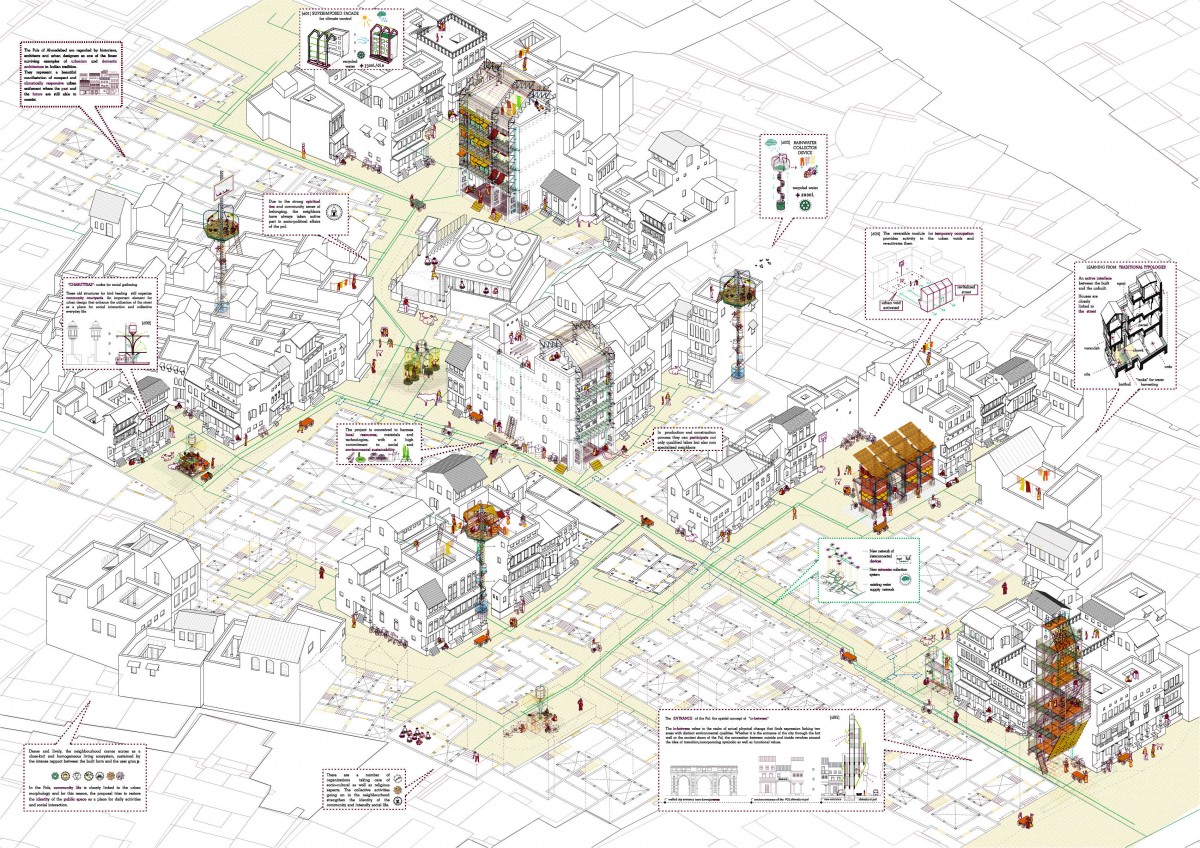
“Urban Strategies to Regenerate Indian Public Space” by Almudena Cano
text by Almudena Cano
Ahmedabad is a city at the heart of the debate over the renovation of its urban fabric. Traditional neighbourhoods in the historic city centre, the Pols of Ahmedabad, are currently facing the effects of external forces, result of rapid development and hard socio-economic pressures. These areas are regarded by historians, architects and urban designers as one of the finest surviving examples of urbanism and domestic architecture in Indian tradition. They represent a beautiful manifestation of compact and climatically responsive urban settlement where the past and the future are still able to coexist. In the Pols, community life is closely linked to the urban morphology and for this reason, the proposal started visualizing daily patterns of use of the space and identifying the precise socio-spatial conditions needed for rebuilding a collective identity within the neighbourhood.
Blurring the boundaries between conventional dichotomies of formal and informal, the Indian urban fabric is continuously updated by everyday users, who correct its planning failures. Dense and lively, the neighbourhood comes across as a close-knit living ecosystem underpinned by an intense connection between the built environment and the user group. Participation in this context takes the form of unmediated negotiation between the users, who spontaneously adapt the rules and programmes of the space to their everyday needs, thus becoming themselves active agents of change. In light of these observations, the project sought to explore design’s potential to support different forms of user engagement with the urban landscape and reinforce ongoing social, economic and environmental dynamics. The Pols are understood as a space for interaction and mediation that sustains collective living, and thus democratizes public space in a renewed domestic dimension. The project ultimately reflects on an expanded meaning of public space, while challenging the way it is conceived and produced.

“Urban Strategies to Regenerate Indian Public Space” by Almudena Cano
An itemized analysis of the area revealed the need to reduce the scale of intervention and reorganise neighbourhood spaces around the day-to-day collective experiences of the inhabitants. The proposal conceives an adaptive system of micro-intervention prototypes that functions on the small-scale, replaces obsolete infrastructures and allows the community to manage their own resources; including water, electricity and waste. Five test cases were identified as representative sites for describing how the system operates and implanting a network of interconnected devices that positively transform and regenerate those scenarios. Intervention devices are designed to reorganize the existing urban scene by restoring the identity of the public space as a place for daily activities and intensification of social life. These artifacts are conceived to harness local resources, materials and technologies, with a high commitment to social and environmental sustainability.
Rather than determine a fixed design solution, the project offers a catalogue of tools that refers to appropriate and appropriable technologies. A number of structural systems, climate control mechanisms and recycling technologies, were categorized in order to preserve and update traditional know-how. Accordingly, the catalogue takes into account the specificities of the place and local structures of production, along with the environmental impact and social relationships associated with production. Here, technologies define the contexts of knowledge that fosters common intelligence and self-organisation. Innovation and technology transfer play an important role in social development through their contributions to city growth.
The wide range of urban tools is provided to allow for flexible adjustments to a constantly changing urban fabric. Each transformation device is conceived to respond to site-specific conditions of five case study scenarios: the new housing blocks, the rooftops, the incidental common courtyards, the vacant spaces and the main entrance of the Pol. These urban situations determine unsolved spatial problems of the neighbourhood and present opportunities to restore the quality of the local landscape. They are taken as a working instrument to test particular interventions that despite different scales, functions and construction processes, all have a shared architectural language.
Examples of this exploration are the façade superimposed to the new housing blocks that offers an extra semi-exterior space for socializing, the common urban kitchen that reorganizes the small courtyards where women used to cook together, the rainwater collector point inserted in-between the rooftops, the reversible module for temporary occupation of underused spaces and the vertical structure with community facilities that restores the entrance entity. These interventions not only guarantee the continuity of traditional ways of life by providing adequate spaces for daily activities such as cooking, washing, gathering or playing; but they also apply energy saving methods, water reuse and recycling technologies in order to move forward towards a more sustainable future.
“Urban Strategies to Regenerate Indian Public Space” calls for an integral approach in the revitalization of traditional urban areas focused on: natural, social and cultural resources; sustainable local technologies; and both individual and collective values. In contrast to urban regeneration programs that ignore existing architectural and cultural heritage, this project proposes a potential methodology to re-programme and re-imagine outdated neighbouthoods: a catalogue of urban tools for tactical interventions that both solve the lack of infrastructure and restore the common spaces where local life unfolds with its distinct qualities.
Almudena Cano Piñeiro portfolio. Read the biography
